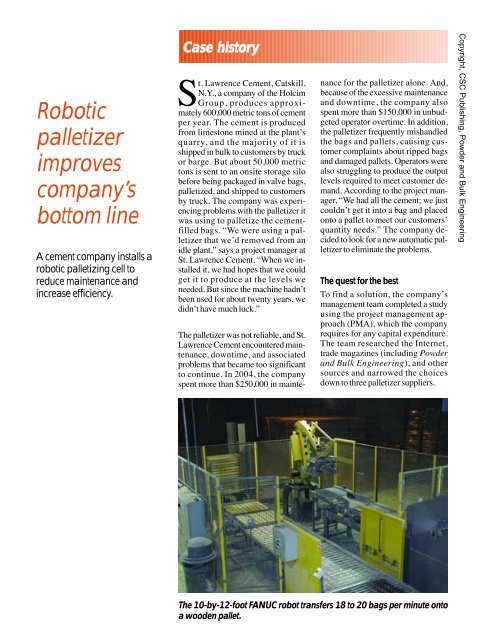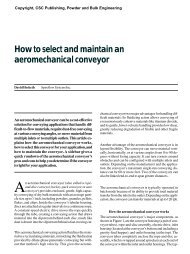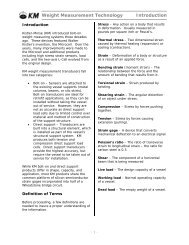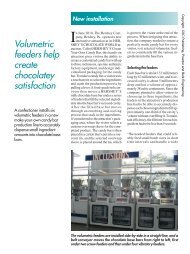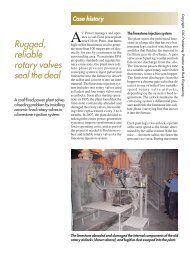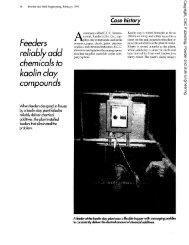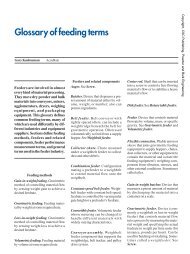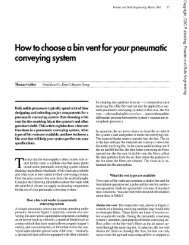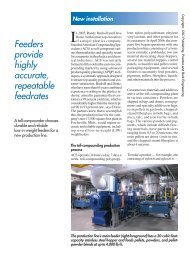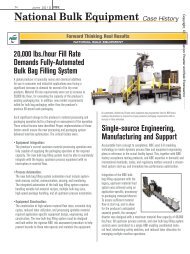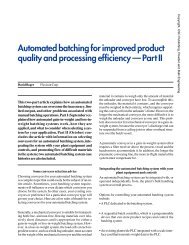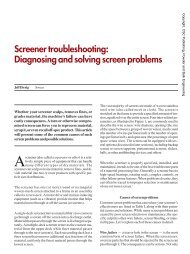Robotic palletizer improves company's bottom line - Powder and ...
Robotic palletizer improves company's bottom line - Powder and ...
Robotic palletizer improves company's bottom line - Powder and ...
- No tags were found...
You also want an ePaper? Increase the reach of your titles
YUMPU automatically turns print PDFs into web optimized ePapers that Google loves.
<strong>Robotic</strong><strong>palletizer</strong><strong>improves</strong>company’s<strong>bottom</strong> <strong>line</strong>A cement company installs arobotic palletizing cell toreduce maintenance <strong>and</strong>increase efficiency.Case historySt. Lawrence Cement, Catskill,N.Y., a company of the HolcimGroup, produces approximately600,000 metric tons of cementper year. The cement is producedfrom limestone mined at the plant’squarry, <strong>and</strong> the majority of it isshipped in bulk to customers by truckor barge. But about 50,000 metrictons is sent to an onsite storage silobefore being packaged in valve bags,palletized, <strong>and</strong> shipped to customersby truck. The company was experiencingproblems with the <strong>palletizer</strong> itwas using to palletize the cementfilledbags. “We were using a <strong>palletizer</strong>that we’d removed from anidle plant,” says a project manager atSt. Lawrence Cement. “When we installedit, we had hopes that we couldget it to produce at the levels weneeded. But since the machine hadn’tbeen used for about twenty years, wedidn’t have much luck.”The <strong>palletizer</strong> was not reliable, <strong>and</strong> St.Lawrence Cement encountered maintenance,downtime, <strong>and</strong> associatedproblems that became too significantto continue. In 2004, the companyspent more than $250,000 in maintenancefor the <strong>palletizer</strong> alone. And,because of the excessive maintenance<strong>and</strong> downtime, the company alsospent more than $150,000 in unbudgetedoperator overtime. In addition,the <strong>palletizer</strong> frequently mish<strong>and</strong>ledthe bags <strong>and</strong> pallets, causing customercomplaints about ripped bags<strong>and</strong> damaged pallets. Operators werealso struggling to produce the outputlevels required to meet customer dem<strong>and</strong>.According to the project manager,“We had all the cement; we justcouldn’t get it into a bag <strong>and</strong> placedonto a pallet to meet our customers’quantity needs.” The company decidedto look for a new automatic <strong>palletizer</strong>to eliminate the problems.The quest for the bestTo find a solution, the company’smanagement team completed a studyusing the project management approach(PMA), which the companyrequires for any capital expenditure.The team researched the Internet,trade magazines (including <strong>Powder</strong><strong>and</strong> Bulk Engineering), <strong>and</strong> othersources <strong>and</strong> narrowed the choicesdown to three <strong>palletizer</strong> suppliers.Copyright, CSC Publishing, <strong>Powder</strong> <strong>and</strong> Bulk EngineeringThe 10-by-12-foot FANUC robot transfers 18 to 20 bags per minute ontoa wooden pallet.
One of those suppliers was PremierTech Systems, Rivière-du-Loup, Quebec,a manufacturer of powder <strong>and</strong>bulk solids processing, weighing, <strong>and</strong>packaging equipment. The plant’s projectmanager visited one of the supplier’sinstallations in Detroit toobserve a <strong>palletizer</strong> during production.Pleased with the equipment’s efficiency,the project manager requestedthat the supplier visit the company’sterminal <strong>and</strong> submit a quote.Gary Ritter, Premier Tech sales manager,came to observe the company’sprocess. “Our company approachessales calls a little differently thanmost,” says Ritter. “We initially take aconsultant role to try to underst<strong>and</strong> thecompany’s needs <strong>and</strong> wants. It’s moreof an informal consult since we’re notnecessarily looking to fit their foot inour shoe, we’re just trying to figure outwhat shoe fits their foot.” Ritter met<strong>and</strong> talked with the company’s management,operators, <strong>and</strong> maintenancestaff to gather the required informationfor a proposal. The company also filledout an application data sheet, whichconsisted of questions about pallet size<strong>and</strong> design, material, load weight, <strong>and</strong>infeed direction.Based on the gathered information,the supplier determined that the bestequipment for the application wouldbe a robotic palletizing cell. A roboticpalletizing cell consists of a robot <strong>and</strong>any ancillary equipment — typicallyconveyors, pallet dispensers, <strong>and</strong> shipor tier sheet dispensers — enclosedby a safety fence.The robot, also called a robotic <strong>palletizer</strong>,is a type of automatic lowlevel<strong>palletizer</strong>. With low-level<strong>palletizer</strong>s, the pallet <strong>and</strong> bags areconveyed to the <strong>palletizer</strong> at floorlevel. The bags are then typically layeredonto the pallet until the pallet isfilled. The loaded pallet exits at floorlevel. In contrast, a pallet enters ahigh-level <strong>palletizer</strong> at the <strong>palletizer</strong>’s<strong>bottom</strong> <strong>and</strong> rises to the top to beloaded. As bags are loaded onto thepallet, the pallet lowers back to theground until it’s full, exiting at themachine’s <strong>bottom</strong>.“Either a high-level <strong>palletizer</strong> or a robotic<strong>palletizer</strong> would have worked inthis situation,” says Ritter. “But weproposed a robot because it’s such alow-maintenance piece of equipment.We knew it would enable the companyto get more product out the door withfewer manhours because there wouldbe less downtime. And that would fulfillSt. Lawrence’s main goal, whichwas to improve efficiency.”Copyright, CSC Publishing, <strong>Powder</strong> <strong>and</strong> Bulk EngineeringThe robotic cell, which is surrounded by an 8-foot-high safety fence, isabout 30 feet long <strong>and</strong> 15 feet wide.
The company also got quotes fromthe other two suppliers, but decidedthat Premier Tech’s solution was thebest fit. “Maintenance is a primaryconsideration when we buy newequipment,” says the project manager.“When we examine new equipment,we’re always looking at it froma maintenance viewpoint. How easyis it to perform maintenance? Howmany maintenance points are there?We definitely made that a priority inour decision. The old <strong>palletizer</strong> hadmore than five thous<strong>and</strong> maintenancepoints on it, which are physical pointson the equipment that need to be individuallymaintained. The proposedrobotic cell had less than one thous<strong>and</strong>points, a substantial improvement.This purchase was an obviouschoice.”The robotic palletizing cell was purchasedin February 2005, <strong>and</strong> the systemwas shipped <strong>and</strong> installed in May2005. The company’s operators installedthe equipment with one of thesupplier’s service technicians presentto supervise. The company initiallyscheduled the installation to takeabout 15 days. However, operators removedthe old machine in 24 hours<strong>and</strong> had the new machine installed<strong>and</strong> running within 5 days. It took 2additional days to adjust <strong>and</strong> refinethe system until it ran perfectly.The robotic cell proves its worthThe custom-configured model AR-201 robotic palletizing cell consists ofa FANUC M-410iB/160 robot, conveyors,a pallet dispenser, a bag-rejectslide, a square roller table, <strong>and</strong> an infeedtable. The robotic cell is about 30feet long <strong>and</strong> 15 feet wide <strong>and</strong> is surroundedby an 8-foot-high safetyfence with an interlocked access door.The fully automated robotic cell canh<strong>and</strong>le up to 27 bags per minute.The 10-by-12-foot robot is manufacturedby FANUC <strong>Robotic</strong>s America,Rochester Hills, Mich. The robot hasfour motion axes to provide fast cycletimes <strong>and</strong> high throughput. The robothas a st<strong>and</strong>ard control package thatoffers a quick-change amplifier <strong>and</strong>fast boot-up time. “The supplier manufacturedall the ancillary equipmentin the cell,” says the project manager.“They integrated the FANUC robotinto their system to provide us with acustomized solution. They also providedan Allen-Bradley man-machineinterface to integrate theequipment, which has a one-touchcontrol panel that we do all of ourtroubleshooting with. It’s very easy touse.”The palletizing process is relativelysimple. A manual valve-bag packingsystem is located upstream from therobotic cell. The cement is typicallypackaged as 94-pound bags of Portl<strong>and</strong>cement. (Approximately 10 percentis packaged as 70- or 74-poundbags of masonry cement.) After a baghas been filled <strong>and</strong> closed, it dischargesfrom the bagger <strong>and</strong> falls ontoa chain belt conveyor, which conveysthe bag to a rubber belt conveyor. Thisconveyor carries the bag to a bag-rejectslide, which is set at a 26-degreeangle approximately 7 feet off thefloor.“The reject slide is an important stepin the process,” says the project manager.“If an operator sees a damagedor a broken bag, he or she can hit aswitch <strong>and</strong> the bag will be rejected beforeit enters the cell. This helps controlthe final product.”From the reject slide, the bag entersthe robotic cell via a square roller conveyor,which is essentially a flatteningtable that evens out the cement’sdistribution in the bag so that the bagwill lie better on the pallet. A pacingconveyor then conveys the bag intothe robot’s pickup point, also calledan infeed table. The robot automaticallysenses that a bag is waiting onthe infeed table, picks it up using agripper, <strong>and</strong> places it on a 46-by-38-inch wooden pallet. The robot thenpicks up a second bag <strong>and</strong> places itnext to the first. When the pallet surfaceis covered with bags, the robotbegins placing bags in a second layer,The Allen-Bradley man-machineinterface has a one-touch controlpanel for quick <strong>and</strong> easy troubleshootingof the robotic palletizingcell.then a third, <strong>and</strong> so on, until 40 bagsare stacked onto the pallet in a programmedpattern.The full pallet is discharged <strong>and</strong> exitsthe robotic palletizing cell by a gravityconveyor. The pallet is then conveyedto a Wulftec WCA-200stretch-wrapper that automaticallystretch-wraps the pallet to prevent thebags from shifting during shipping.The stretch-wrapped pallet is conveyedalong the gravity conveyor,picked up by a forklift, <strong>and</strong> placed in aholding area until it’s shipped to acustomer. In the meantime, an emptypallet is dispensed from a pallet dispenserlocated near the robot, <strong>and</strong> thepalletizing process repeats.“One of the great things about the systemis its simplicity,” says Ritter.“The robot does all the work automatically.It can be programmed to run atdifferent speeds, depending on howfast the operator bags the cement. Inthis application, it’s running at aroundeighteen to twenty bags per minute.”The robotic cell lives up to itsreputationThe robotic cell requires very littlemaintenance to be kept in perfectworking condition. Once a year, thesystem is shut down for normal wear<strong>and</strong>-tearmaintenance on the infeedCopyright, CSC Publishing, <strong>Powder</strong> <strong>and</strong> Bulk Engineering
<strong>and</strong> outfeed sections, including cleaning<strong>and</strong> replacing consumable rubber<strong>and</strong> roller components. During thistime, a FANUC maintenance techniciancomes to the terminal to performpreventive maintenance on the robot.The robotic cell is currently coveredunder the original preventive maintenanceprogram. But, when that expiresthis year, the company plans tosign up for the supplier’s PM-5 aftermarketsupport program. This newprogram offers five levels of preventivemaintenance service. The suppliermaintains a database with a listof scheduled visits for preventivemaintenance <strong>and</strong> automatically setsup the appointment, leaving the customerwith little to worry about.The robotic cell has eliminated theexcessive overtime that previouslyplagued the company, significantlyimproving productivity.The supplier also has a help deskavailable for any problems that mayarise. “Our company has worked withmany high-end, reputable suppliersover the years,” says the project manager.“And, by far, this suppliers’s responseto issues <strong>and</strong> problems hasbeen the best we’ve ever experienced.The help desk people have been quickto respond, <strong>and</strong> their knowledge ofthe equipment <strong>and</strong> the process is insurmountable.Every time we’ve hada question, each person has turnedaround within one hour with an answer.And nine times out of ten wecan fix the problem at the touchpadcontroller, which is very userfriendly.”switch bag sizes, we have to make thetension on the gripper tighter orlooser. In doing so, we’ve accidentallybroken off part of the robot armon the gripper. But other than that,we’ve had zero downtime.” The suppliersays the mean time between failureson the robot is generally about60,000 operating hours.The robotic cell has eliminated the excessiveovertime that previouslyplagued the company, significantlyimproving productivity. For example,in 2004, operators were struggling topalletize 1,500 to 1,700 bags in an 8-hour period. With the new system, operatorscan palletize more than 5,000bags within the same timeframe. Thiscut labor costs significantly while stillachieving the output levels required tomeet customer needs. “We predicted atwenty percent increase in businessonce the new equipment was installed,”says the company’s managementteam. “Incredibly, we ended upwith an increase of more than thirtyfivepercent.” The company’s customershave been pleased with theincreased output levels as well as thefinal product.“We’ve had only minor problemswith the robotic cell,” says the projectmanager. “We’ve been extremelyhappy both with the equipment <strong>and</strong>the excellent service we’ve received.This installation has been a great successstory.”PBENote: To find other articles on thistopic, look under “Bagging <strong>and</strong> packaging”in <strong>Powder</strong> <strong>and</strong> Bulk Engineering’sArticle Index at www.powderbulk.com or in the December 2005issue.Copyright, CSC Publishing, <strong>Powder</strong> <strong>and</strong> Bulk EngineeringThe new robotic cell runs like adreamSince installation, the robotic palletizingcell hasn’t had any problems or requiredany major repairs orreplacements. “The only repairswe’ve had to make have been minor,”says the project manager. “When wePremier Tech Systems,Rivière-du-Loup, QC418-868-8324www.premiertechsystems.com


